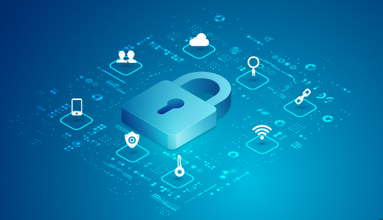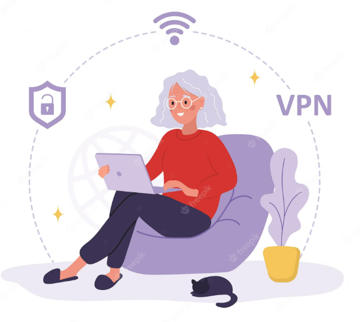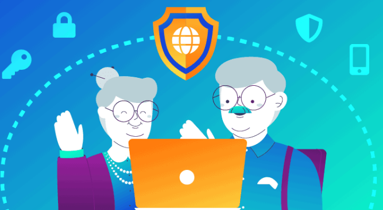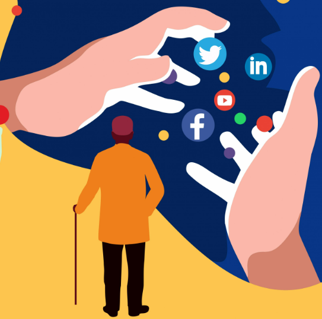 Introduction to Cyber Security Introduction to Cyber SecurityUnderstanding Cyber Security Risks Click to read
| Think of cyber security risks as potential hazards when you go online. Just like you take precautions to stay safe in the physical world, such as locking your doors, being aware of cyber risks helps you stay safe in the digital world. These risks can include things like hackers trying to steal your personal information, scams that trick you into giving away your money, or viruses that can harm your computer. Moreover, cyber security emphasizes the cultivation of a security-conscious culture by promoting awareness and education about safe online practices. |
 |
By learning about these risks, you can better protect yourself. It's like knowing the signs of a slippery floor so you can walk carefully and avoid falling. We will discuss common cyber risks and how to recognize them, so you can navigate the online world with confidence and make informed choices to keep yourself and your information secure. Remember, knowledge is power, and by understanding cyber security risks, you are taking an important step towards protecting yourself online.
Common Types of Cyber Threats Click to read
In this unit, we will explore the common types of cyber threats, which are different ways that bad actors try to harm you or your computer when you are using the internet. Understanding these threats helps you stay safe and avoid potential harm. Let's break it down in simple terms.
Think of cyber threats as sneaky tricks or traps that bad people use online. They want to steal your personal information, infect your computer with harmful software, or trick you into giving them your money. Some common types of cyber threats include things like phishing, malware, and identity theft.
Phishing is like a fake email or message that pretends to be from someone you trust, but it's trying to trick you into giving away your personal information. It's like someone pretending to be a friend to get access to your secrets. Common phishing messages are: fake emails from the bank, false reports of winnings from gambling or games of chance or free prizes, fake accounts of providers of IT or payment services or Internet stores, false confirmations of purported orders or false payment reminders, false messages about personal data privacy policies or terms that should be accepted.
The phishing e-mail message may say: Your credit card has expired, your account has expired, temporarily blocked, or confirm your login information. Layout (corporate design), sender address or directly greeting the user they can create the impression that it is an e-mail sent by a bank or other provider service. E-mail messages in HTML format display a "legal" link to the recipient, which contains a hidden link in the background, which leads directly to fraudulent or malicious content.
Malware is like a virus that can infect your computer and cause damage. It can make your computer slow down or even steal your personal information.
Identity theft is when someone steals your personal information, like your name, address, or credit card details, and uses it without your permission. It's like someone pretending to be you and using your money or buying things on your behalf.
Identity thieves can also in their e-mail messages integrate malware such as viruses
or Trojan software as a link, attachment, or source code in an email message in HTML format. Just click on the image in the Phishing message can have serious consequences. Fraudsters who steal identities often use addresses that differ only slightly from the original ones. An identity thief can replace characters to create fake URLs. For example, instead of the original addresses such as http://www.onlinebank.com.hr can be fake representation use address such as http://www.on1inebank.com.hr.
How to be aware if something is malicious?
- FAKE SENDER ADDRESS
Hover your mouse over the sender's address. Does the email address contain suspicious elements? Are there spelling mistakes in the address, even if they were insignificant?
- REQUEST FOR CONFIDENTIAL DATA
Does the link contained in the e-mail ask you to enter personal information? Are you required to provide confidential information such as PINs or passwords?
- URGENCY
Does the e-mail request that you act immediately or urgently? Does the message contain a threat or a warning?
- LINKS TO FAKE WEBSITES
What URL appears when you mouse over a link? Is it a secure page (URL should start with “https://”) and encrypted (lock symbol in front of the URL)?
- STRANGE FORMULATIONS AND SPELLING ERRORS
Is the email greeting generic? Does it contain spelling errors, incorrect punctuation, or special signs?
By learning about these common types of cyber threats, you can recognize them and take steps to protect yourself. We will discuss strategies to stay safe and avoid falling victim to these threats, empowering you to enjoy the online world with confidence and peace of mind.
Importance of Cyber Security for Seniors Click to read
Think of cyber security as your personal bodyguard in the digital world, looking out for your well-being. It's like having someone watching over you, making sure your personal information stays safe and your devices remain secure. To ensure cyber security, we need to practice safe online habits, such as creating strong and unique passwords, being cautious about clicking on suspicious links or downloading files from unknown sources and keeping our devices and software up to date.
- Never confirm your account number, password, or other secret information if requested in an email message. Real banks and companies would never use such for security reasons.
- Check the security status of websites before you enter your personal data. HTTPS does not guarantee that a website is real. Click on the padlock symbol displayed next to the URL in your browser to check the security certificate of the website.
- Belief in the infallibility of technology can leave room for Phishing attacks. A healthy level of mistrust prevents attackers from stealing your identity and access to your accounts and information systems.
 Safe Internet Browsing Safe Internet BrowsingBest practices to keep yourself safe in the digital environment Click to read
- Practice Safe Browsing Habits: Stick to trusted websites when shopping, banking, or sharing personal information online. Look for the padlock symbol and "https://" in the website address, indicating a secure connection.
- Be Wary of Social Engineering: Beware of unsolicited calls, messages, or emails requesting personal information or financial details. Legitimate organizations will not ask for such information through unsolicited means
- Backup Your Data Regularly: Create backups of your important files and data on a separate storage device or cloud service. This helps protect against data loss due to hardware failure, theft, or ransomware attacks.
- Enable Two-Factor Authentication (2FA): Activate 2FA whenever available. This adds an extra layer of security by requiring a secondary verification step, such as a unique code sent to your mobile device, in addition to your password.
- Be Mindful of Social Media Sharing: Exercise caution when sharing personal information, location details, or vacation plans on social media platforms. Oversharing can provide valuable information to cyber criminals or potential burglars.
- Secure Your Mobile Devices: Apply security features, such as passcodes, fingerprint, or facial recognition, to lock your smartphones and tablets. Install reputable security apps that offer features like remote tracking and wiping in case of loss or theft.
- Trust Your Instincts: If something seems too good to be true or feels suspicious, trust your instincts. Be skeptical of unexpected offers, requests for money, or urgent appeals for personal information.
- Clear Browsing Data Regularly: Clear your browsing history, cookies, and cached data on a regular basis. This helps protect your privacy by removing stored information that could potentially be accessed by unauthorized individuals.
|
 |
Enhancing Online Safety with Secure Browsing Tools Click to read
|
Enhancing online safety with secure browsing tools is an important aspect of cyber security. By utilizing these tools, you can protect your privacy, secure your personal information, and reduce the risk of online threats. Here are some essential tips to enhance your online safety with secure browsing tools:
- Install and Use a Trusted Web Browser: Choose a reputable web browser, such as Google Chrome, Mozilla Firefox, or Microsoft Edge. These browsers prioritize security and regularly release updates to address vulnerabilities.
- Activate the Browser's Security Features: Familiarize yourself with the security features offered by your web browser. Enable features such as pop-up blockers, safe browsing mode, and privacy settings to enhance your online safety.
|
 |
- Enable Phishing and Malware Protection: Activate the built-in phishing and malware protection features offered by your web browser. These features can warn you about suspicious websites and prevent you from visiting known malicious sites.
- Stay Educated and Updated: Stay informed about the latest online threats and best practices for secure browsing. Regularly read reliable sources, such as reputable cybersecurity websites or blogs, to stay up to date with the evolving landscape of online security.
|
 |
 Health and Well-being in the Digital Age Health and Well-being in the Digital AgeRisks of Excessive Screen Time and Digital Dependency Click to read
To mitigate the risks of excessive screen time and digital dependency, here are some strategies and practices to consider:
- Set Screen Time Limits: Establish specific time limits for using screens, both for leisure activities and work-related tasks. This helps create a healthy balance between screen time and other activities.
- Take Regular Breaks: Incorporate regular breaks from screens into your daily routine. Stand up, stretch, and engage in physical activities or hobbies that don't involve digital devices.
|
 |
- Practice Digital Detox: Dedicate specific periods, such as weekends or evenings, to disconnect from digital devices entirely. Use this time to engage in offline activities, spend time with loved ones, or pursue hobbies.
- Practice Mindful Technology Use: Be mindful of how you use technology and the impact it has on your well-being. Reflect on your digital habits, assess their effects on your life, and make conscious choices to minimize negative consequences.
- Seek Support and Accountability: Share your concerns with trusted family members, friends, or support groups. Establish mutual accountability to encourage responsible technology use and provide support in maintaining healthy habits.
- Set Digital Boundaries: Define clear boundaries for technology use, such as turning off notifications during specific times, avoiding screen time before bed, or setting guidelines for device use during family meals.
Remember, the goal is to develop a healthy relationship with technology and ensure that it enriches your life rather than becoming a source of excessive dependence. By implementing these strategies, you can mitigate the risks associated with excessive screen time and promote a more balanced and fulfilling lifestyle.
Health and digital tools Click to read
Technology can offer numerous ways to support and improve your health. Here are some ways in which technology can help you with your health:
- Access to Information: The internet provides a wealth of health-related information, allowing you to research symptoms, conditions, treatments, and preventive measures. Reliable websites, health apps, and online communities can empower you to make informed decisions about your health.
- Health Monitoring: Wearable devices, such as fitness trackers and smartwatches, can monitor various aspects of your health, including heart rate, sleep patterns, physical activity, and calories burned. These devices can provide valuable insights into your overall well-being and help you track progress toward health goals.
|
 |
- Telehealth and Remote Consultations: Telehealth services allow you to consult healthcare professionals remotely through video calls or online chats. This convenient approach saves time and can be particularly beneficial for follow-up appointments, routine check-ups, or non-emergency medical consultations.
- Medication Management: Mobile apps and smart pill organizers can help you manage medications by providing reminders for taking pills, tracking medication schedules, and providing alerts for prescription refills. This technology can prevent missed doses and promote adherence to medication regimens.
- Mental Health Support: Various mental health apps and online platforms provide resources for managing stress, anxiety, and depression. These tools can include guided meditation, breathing exercises, mood tracking, and therapy sessions conducted through digital platforms.
- Health Record Management: Digital health records and patient portals enable you to access and manage your medical history, test results, and appointment schedules. This streamlines communication with healthcare providers and ensures continuity of care.
- Support and Motivation: Online communities and social media platforms dedicated to health and wellness can provide support, motivation, and encouragement. Connecting with like-minded individuals can foster a sense of community and help you stay accountable to your health goals.
- Health Tracking and Data Analysis: Technology allows you to track and analyze health data over time, such as blood pressure, blood glucose levels, or weight. By monitoring trends and patterns, you can identify areas for improvement and make necessary adjustments to optimize your health.
Remember, while technology can be a valuable tool in supporting your health, it's important to use it wisely and in conjunction with professional medical advice. Always consult healthcare professionals for accurate diagnosis, treatment recommendations, and personalized guidance.
Summing up Click to read
|
Well done! Now you know more about:
 Seniors are now aware of online dangers and how to protect themselves. They know about risks like personal information theft, scams, and viruses. This knowledge helps them make informed choices and stay safe online. Seniors are now aware of online dangers and how to protect themselves. They know about risks like personal information theft, scams, and viruses. This knowledge helps them make informed choices and stay safe online.
 Seniors recognize different cyber threats, such as phishing, malware, and identity theft. They can identify warning signs and take steps to avoid falling victim to these threats. Seniors recognize different cyber threats, such as phishing, malware, and identity theft. They can identify warning signs and take steps to avoid falling victim to these threats.
 Seniors learned how technology can support their health, providing access to information, health monitoring, online communities, and the ability to track and analyze health data. Seniors learned how technology can support their health, providing access to information, health monitoring, online communities, and the ability to track and analyze health data.
|
 |
|

 Introduction to Cyber Security
Introduction to Cyber Security




